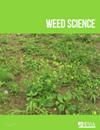Physical and Physiological Pathways of Off-Target Triclopyr Movement and Associated Non-target Injury following Basal Bark Application
IF 2.5
2区 农林科学
Q2 AGRONOMY
引用次数: 0
Abstract
Abstract Basal bark treatment with triclopyr butoxyethyl ester is used to control woody invasive plants, including Brazilian peppertree ( Schinus terebinthifolius Raddi). However, the ester formulation cannot be applied where standing water is present, which includes wetlands where S. terebinthifolius is found. In 2009, a low-volatile acid formulation of triclopyr was labeled for use in aquatic sites which allows for basal bark applications when standing water is present. This formulation may have utility for controlling woody plants in standing water. However, anecdotal observations of injury to non-target plants following applications during periods of inundation have been reported. To address this, mesocosm studies were conducted to assess non-target injury through triclopyr root exudation or release from the surface of treated stems via flooding. Mesocosms contained S. terebinthifolius as the treated target while sugarberry ( Celtis laevigata Willd.), buttonbush ( Cephalanthus occidentalis L.), and red maple ( Acer rubrum L.) were included as non-targets. In the first study, the pathway of root exudation for non-target injury following triclopyr (34 g L -1 ) basal bark application was isolated with activated charcoal placed at the soil surface. In the second study, mesocosms were flooded to assess triclopyr release from the surface of treated stems and subsequent non-target injury. Defoliation of non-target species post-treatment was ≤ 8% and triclopyr was detected at ≤ 5 µg L -1 in mesocosm wells when activated charcoal was present. Post-treatment non-target defoliation up to 92%, coupled with triclopyr concentrations in surface waters and wells as high as 4,637 µg L -1 , indicated triclopyr movement as a result of flooding. Additionally, triclopyr non-target injury from soil activity independent of flooding was observed. These findings provide limited evidence of triclopyr root exudation but considerable evidence of triclopyr release during flooding following basal bark treatment and support a cautionary approach to basal bark application when standing water is present.基皮应用后脱靶三氯吡啶运动和相关非靶损伤的物理和生理途径
摘要/ Abstract摘要:采用丁氧乙基酯三氯吡啶对巴西胡椒树(Schinus terebinthifolius Raddi)等木本入侵植物进行基皮处理。然而,酯制剂不能应用于存在死水的地方,包括发现S. terebinthifolius的湿地。2009年,一种低挥发性酸制剂三氯吡啶被标记为用于水生场所,允许在存在静水的情况下应用于基树皮。该配方可用于控制静水中的木本植物。然而,据报道,在淹没期间施用后对非目标植物造成伤害的轶事观察。为了解决这个问题,进行了中观研究,以评估通过三氯吡啶根渗出或通过淹水从处理过的茎表面释放的非靶标损伤。中观目植物以特林荫属(S. terebinthifolius)为处理目标,以糖果(Celtis laevigata Willd.)、洋油桐(Cephalanthus occidentalis L.)和红枫(Acer rubrum L.)为非处理目标。在第一项研究中,用活性炭在土壤表面分离了施用三氯吡啶(34 g L -1)后根渗出的非目标损伤途径。在第二项研究中,研究人员对经处理的茎干表面的三氯吡嗪释放和随后的非靶损伤进行了研究。处理后非目标物种的落叶率≤8%,在活性炭存在的情况下,三氯吡虫啉在介膜孔中检测到≤5µg L -1。处理后的非目标落叶率高达92%,加上地表水和井中的三氯吡啶浓度高达4,637 μ g L -1,表明三氯吡啶因洪水而移动。此外,还观察到土壤活动对三氯虫的非目标伤害,而不受洪水的影响。这些发现提供了有限的三氯吡啶根渗出的证据,但相当多的证据表明,在基树皮处理后的洪水期间,三氯吡啶释放,并支持在存在静水时使用基树皮的谨慎方法。
本文章由计算机程序翻译,如有差异,请以英文原文为准。
求助全文
约1分钟内获得全文
求助全文
来源期刊

Weed Science
农林科学-农艺学
CiteScore
4.60
自引率
12.00%
发文量
64
审稿时长
12-24 weeks
期刊介绍:
Weed Science publishes original research and scholarship in the form of peer-reviewed articles focused on fundamental research directly related to all aspects of weed science in agricultural systems. Topics for Weed Science include:
- the biology and ecology of weeds in agricultural, forestry, aquatic, turf, recreational, rights-of-way and other settings, genetics of weeds
- herbicide resistance, chemistry, biochemistry, physiology and molecular action of herbicides and plant growth regulators used to manage undesirable vegetation
- ecology of cropping and other agricultural systems as they relate to weed management
- biological and ecological aspects of weed control tools including biological agents, and herbicide resistant crops
- effect of weed management on soil, air and water.
 求助内容:
求助内容: 应助结果提醒方式:
应助结果提醒方式:


